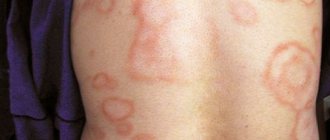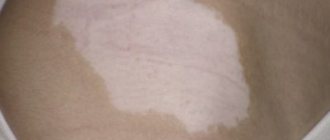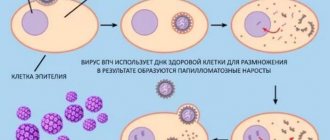Benign neoplasms on the surface of the genitals sometimes degenerate into dangerous tumors, and therefore require special attention. They can appear in both women and men. Why is this happening? The fact is that the formation of papillomas in intimate places is provoked by the HPV virus, which is activated due to decreased immunity.
Causes of growths on the genitals
Papilloma is a warty, benign formation that develops from epithelial cells. Its appearance is associated with the development of papillomatosis, i.e., an infectious disease caused by the human papillomavirus (HPV). Depending on the strain of the virus, its oncogenicity is high and low, which represents the main danger of the pathology.
The disease affects people of both sexes almost equally, with the intimate area being one of the most vulnerable places. In men, papillomas are found on the penis and on the skin of the scrotum. For women, localization is typical on the labia minora and majora, in the vaginal cavity, on the surface of the cervix. Representatives of both sexes often suffer from the appearance of anal formations.
Infection most often occurs through sexual contact with an infected partner, and even using a condom does not always help. The virus is present in almost all biological fluids, which creates the risk of transmitting HPV through contact, when wearing someone else's underwear, in a bathhouse or swimming pool. A child can become infected in the womb or during childbirth.
Important!
HPV, having penetrated the human body, remains so forever, and so far there is no means to destroy it. Only its manifestations in the form of papilloma are removed.
The immune system in a normal state is able to effectively resist the virus, driving it into a latent state for a long time. Activation of HPV, leading to the growth of papilloma, occurs when favorable conditions appear. The following provoking factors can be identified:
- deterioration of immune defense, immunodeficiency;
- intoxication of the body;
- hormonal imbalance;
- prolonged and frequent physical overload;
- stress and nervous overload;
- poor environment, harmful emissions in production;
- uncontrolled use of certain drugs (cytostatics, immunosuppressants, antibiotics).
In women, the risk of papilloma increases significantly during pregnancy. In addition, they can occur when taking oral contraceptives, vaginal rings and spirals.
Symptoms of the disease
When exposed to human papillomavirus, clinical symptoms may not appear immediately. The first signs appear when the body's defenses decrease. In this case, the infectious agent infects the epithelium, provoking its growth. Unsightly growths form, which sometimes itch and hurt. Their localization may vary, but location on the genitals is considered the most dangerous. In this case, you need to contact specialists . They are working on solving this problem:
- dermatologist;
- urologist;
- surgeon;
- gynecologist;
- oncologist.
In men, HPV symptoms appear on the penis, especially around the glans, on the skin of the scrotum and perianal area. In a woman, this is the area of the labia minora, the inner wall of the vagina, the skin around the anus and the cervix.
If a person has papillomas on the genitals, he is 100% likely to infect his sexual partner through unprotected sex. The vulnerability of the external genitalia to infection is explained by the fact that their skin is quite thin.
Which doctor should I contact?
It is not difficult to identify the presence of papilloma in an intimate place due to their characteristic appearance. In women, the primary diagnosis is made by a gynecologist during a routine examination or targeted treatment. A man should consult a dermatologist. When developing a treatment regimen, specialists such as an immunologist and an infectious disease specialist are usually involved. A consultation with a surgeon will be required to prescribe surgical treatment.
Important!
You should not self-medicate. This can lead to dangerous complications. All medical procedures, including the use of herbal medicine, should be agreed with a doctor.
The effectiveness of different approaches
The effectiveness of approaches to solving this problem depends on many factors. First of all, a person who notices a growth of unknown origin in his intimate part should consult a doctor. After a thorough examination and interpretation of the tests, it will be clear what type of papillomavirus is being fought.
Depending on the individual characteristics of the body, one person can be helped by traditional medicine, and in a fairly short time. And another may face the problem of ineffectiveness of the home remedies used.
In the early stages of the appearance of papillomavirus in the body, you can cope with it yourself. More advanced tumors can develop into malignant tumors and must be removed using surgical techniques.
At home, getting rid of papilloma on intimate parts of the body is a completely doable task. Depending on the sensitivity of the skin, appropriate therapy is selected.
If you are intolerant to natural ingredients, it is recommended to purchase pharmaceutical preparations that can be used independently at home.
How to get rid of tumors using the hardware method?
Treatment of papilloma is based on their removal or destruction. The following hardware methods of influence are recognized as one of the most effective:
- Cryogenic destruction . It is achieved by quick and deep freezing of the affected area using liquid nitrogen. The technology has been used for a long time and is well developed. This method can only be used on the external parts of the organs (penis, labia). It is impossible to remove formations on the vaginal mucosa or cervix. Tissue restoration occurs within 12–15 days.
- Radio wave surgery . A directed radio frequency wave becomes a kind of thin scalpel (“radio knife”), which is capable of influencing tissue with great precision. The most famous source of such radiation is the Surgitron generator. The radioknife excises only the formation without affecting healthy tissue. The impact site heals within a few days, with no side effects detected.
- Electrical coagulation . Electrical destruction of papilloma is ensured by burning them out by exposure to high frequency current (“electronic knife”). After such exposure, all excised vessels are glued together, which stops bleeding. After the operation, only a small scar remains, which resolves over time. This method is considered safe and can even be prescribed to pregnant women.
- Laser surgery . This is one of the most modern and effective ways to remove papilloma. A laser beam is capable of destroying the formation of any germination depth and any location. Postoperative scarring does not occur, and the tissues heal very quickly. The only drawback is that the necessary equipment is available only in specialized clinics.
- Surgical exposure . Traditional excision of the formation with a scalpel is the most traumatic and requires a longer recovery period. Scars remain at the site of exposure for a long time.
The choice of surgical treatment method depends on the advanced stage of the disease, the size of the formation and its location. When operating on the cervix or cervical canal, there should be no scars that could disrupt female reproductive functions. The technology is selected by the doctor based on the results of diagnostic examinations, oncogenicity and the capabilities of the medical institution.
Destruction options
It is impossible to remove large growths in 1 session. If there are many formations, long-term therapy is needed. The required result can be obtained quickly only when hardware methods are used. Such manipulations are allowed if it is determined that there is no risk of malignancy. The procedure is performed only by experienced specialists in a hospital setting.
When it turns out that a wart can develop into a tumor, the patient requires surgical intervention. The operation is also carried out if there are a lot of growths. In this case, the surgeon uses a scalpel. Before mechanical removal, a local anesthetic is injected into the skin. At the end of the procedure, a small scar remains.
Hardware methods are a gentle option for removing growth. Laser therapy is the most popular today. The laser beam acts on the growth and removes it completely, regardless of the location and depth of germination in the tissue. There is no scar left after the manipulation. Other hardware techniques:
- Electrocoagulation. According to this method, using an electric current of constant frequency, tumor tissue is removed, and the vessels are sealed. Capillaries also overlap in healthy tissues located nearby. Electrocoagulation is considered a bloodless method. It leaves a small wound that heals in a matter of days.
- Cryodestruction. Genital tumors are removed with liquid nitrogen through freezing. This local effect is very effective, but is used only for the external genitalia. If HPV has infected the cervix and vaginal mucosa, then freezing with liquid nitrogen is prohibited.
- Radio wave destruction. It involves the use of the Surgitron apparatus, which generates radio waves. They destroy pathological areas of the skin and mucous membrane, but have no effect on healthy tissue.
All these methods make it possible to remove areas of growth on certain parts of the body, but do not fight relapses. Condylomas may appear again after removal if immunity decreases. To avoid their occurrence, it is enough to take immunomodulators and antiviral drugs for a certain duration. The duration of the course of treatment is determined by the doctor.
Medical removal
Papillomas in the intimate area can be removed using medications. They have different mechanisms of action, but all are aimed at reducing the activity of the virus and destroying the formation. The following drugs are most effective:
- Kondilin . It is based on podophyllotoxin, a plant alkoid. This active substance blocks the transport of intracellular nucleotides, which leads to necrosis of the affected epithelial cells and destruction of the papilloma. The drug is available in the form of a 0.5% alcohol solution. They treat the formation for 4 days (2 times a day), and the daily dose is no more than 0.5 ml. The real result appears after 2 days of treatment.
- Solcoderm . The basis of the product is 70% nitric acid. In addition, the composition includes oxalic, acetic and lactic acid, copper nitrate. By treating papilloma, its acid burning is achieved (devitalization and mummification of tissue). The scab formation disappears within 5–10 days. The drug is used once, and the treated area should not exceed 4 sq. cm. Re-use is allowed after 8–10 days. When treating papilloma, extreme care must be taken, applying the composition pointwise, without cauterizing healthy tissue.
- Fluorouracil . This drug is a potent agent used in the fight against malignant tumors. Ointment with 5% fluorouracil is recommended for removing papilloma. This active substance inhibits cell division by blocking DNA synthesis. For papillomatosis, the ointment is used daily for 7 days.
- Imiquimod . When treating papilloma, a 5% cream is used. It is an effective immunomodulator. The drug does not directly affect HPV, but by helping to induce interferon and cytokines, it helps the body fight the infection. The course of treatment is 4 months, during which the cream is applied once every 2 days.
In addition to the most common medications listed, the doctor may prescribe Papilite. Imitation of cryogenic destruction is provided by such means as Cryopharma, Wartner. A decrease in viral activity is achieved by subcutaneous injection of Allokin-Alpha. A positive result is observed with long-term use of oxolinic ointment.
The principle of action of ointments for papillomas
Almost all ointments for papillomas act on the same principle. Their main effect is a powerful antiviral local therapy in combination with stimulation of necrosis of the upper layers of the epithelium (also locally). All this together “kills” the neoplasm and leads to the body rejecting it naturally. For example, lapis pencil, oxolinic ointment, Viferon, salicylic ointment, Panavir work according to this principle (despite the fact that the composition is based on plants).
However, the use of such drugs should be carried out exclusively under the strict supervision of the attending physician. That is, you will need to consult a dermatologist almost every other day. Under no circumstances should these ointments be used on any other neoplasm, be it an ordinary mole or lichen. They are suitable only for papillomas, and an accurate diagnosis can only be made after a histological examination (when a piece of the neoplasm is pinched off and sent for laboratory testing using markers).
Traditional removal methods
Herbal folk remedies can help in the fight against pathology. The greatest effect is achieved by combining herbal medicine with antiviral medications. Folk remedies based on the following medicinal plants are especially popular:
- Celandine . The burning ability of the juice of this plant is used in such a pharmaceutical product as the drug SuperClandestine. Self-squeezed, concentrated juice should be used carefully, avoiding burns to adjacent tissues. Its application is ensured pointwise.
- Kalanchoe . When treating external formations, a plant leaf or a swab soaked in its juice is applied to the affected area. Internal papillomas are lubricated with juice. The treatment is long-term – it may take 1.5–2 months before real results are obtained.
- Aloe . This plant is used similarly to Kalanchoe.
You can supplement drug therapy by taking the following folk remedies:
- Melissa infusion . It is prepared by infusing plant leaves in boiling water, with plant materials and water taken in equal proportions. During the day, drink 3 tablespoons of infusion.
- Sage infusion . The herb (1 tablespoon) is infused in boiling water (500 ml). Drink 1 tablespoon every 3-4 hours.
- St. John's wort decoction . It is prepared at the rate of 10 g of raw material per 200 ml of water. Drink 100 ml before each meal.
- Plantain infusion . The proportions are similar to the previous product. Use 4–5 times a day, 1 tablespoon.
Garlic, which has cauterizing properties, is widely used in folk medicine. With long-term treatment, castor oil shows good results. You can treat the affected areas with fir oil or tea tree oil. You can cauterize the formations with ammonia and hydrogen peroxide, but they must be used with great caution.
Consequences of the disease
Some people are overcome by doubt whether it is necessary to treat papillomas at all. After all, they do not hurt, and in intimate places they are invisible. This must be answered clearly and unambiguously - they need to be treated to avoid serious consequences.
Firstly, the presence of papilloma on the genitals is fraught with mechanical damage when putting on underwear, sexual contact, etc. Small, bleeding wounds appear, which become a favorable environment for various infections. Secondly, the virus in its active state is highly contagious. During sex, the likelihood of infection is very high, which means you should not put your partner at risk.
The most dangerous phenomenon is a tendency to malignancy. Of course, not all HPV strains are oncogenic, but the possibility of transformation of a benign tumor into oncology exists. In men, this phenomenon is practically undetectable, but in women, it is quite possible to provoke vaginal or cervical cancer. A sick woman poses a huge danger to her child.
Salicylic ointment
It has been used for many years to remove papillomas. It cannot be called the most effective, but it copes well with small tumors. In addition, salicylic ointment has no contraindications. It can be applied even to small children whose papillomas appeared in the first year of life. The main thing is to treat exclusively the inflamed area, without affecting healthy skin. But medical consultation is still mandatory.
The advantage of salicylic ointment is:
- very low cost;
- fast action;
- stimulation of epithelial regeneration (accelerates healing).
The only contraindication is individual intolerance to the components of the product.
Prevention
It is much easier to prevent any disease than to treat it. HPV is not excreted from the human body, and therefore it is very important to avoid infection. First of all, casual sex and a large number of sexual partners should be avoided.
If the virus does get inside, then it is necessary to take all measures to increase immunity and eliminate provoking factors. A healthy lifestyle will help with this - giving up bad habits, optimal nutrition, combining activity with proper rest. Diseases, especially those related to the genitourinary system, must be treated promptly and adequately. Taking vitamin complexes will help strengthen the immune system.
How to smear papillomas on intimate places
In medical practice, several main methods are used to remove papillomas:
- surgical extermination implies excision or burning using an electric knife, laser beam, liquid nitrogen or scalpel;
- conservative method - represented by treatment using ointments, tablets and all kinds of suspensions.
It is worth noting that before resorting to drug treatment for an illness, pay attention to traditional methods. They have a more loyal effect on the human body; they can be smeared, rubbed, applied to any part of the epidermis, without harm to health. If you have a negative attitude towards folk remedies, and still decide to treat papilloma in a different way, use ointments to start. They, in turn, will cause less harm than surgical intervention.
This method does not cause complications and has virtually no contraindications. Approach the task conservatively and loyally. Don't take rash steps.
Removal of papilloma in the intimate area - prices
In a market economy, the cost of medical services depends on many circumstances, including the region and category of the clinic. In treatment, you should not look for very cheap options. Such searches can lead to false doctors and charlatans. Such savings can result in loss of health, and subsequent huge costs for its restoration.
To guide you in the cost of papilloma removal services using various methods, you can give the following average values:
- Radio wave technology – 390–410 rubles.
- Electrocoagulation – 600–680 rubles.
- Laser surgery – 400–800 rubles.
- Cryodestruction – 250–350 rubles.
The cost of the procedure depends on the location of the formation and the presence of complicating circumstances.
Currently, there are no ways to completely destroy the papilloma virus, but through effective treatment it can be driven into a latent state for a long time. The manifestation of infection in the form of benign formations can be removed in different ways. This will avoid unforeseen circumstances and dangerous complications.
What medications are used during pregnancy
Need advice from an experienced doctor?
Get a doctor's consultation online. Ask your question right now.
Ask a free question
Most medications are used during pregnancy if the benefit to the mother is greater than the risk to the fetus. During childbirth, the child may become infected through the birth canal; it is advisable to remove the formation.
Since most medications have contraindications during pregnancy, it is preferable to remove them using hardware procedures:
- cryotherapy;
- laser removal;
- radio wave method.
Approved drugs during pregnancy: interferon, viferon, betadine.










